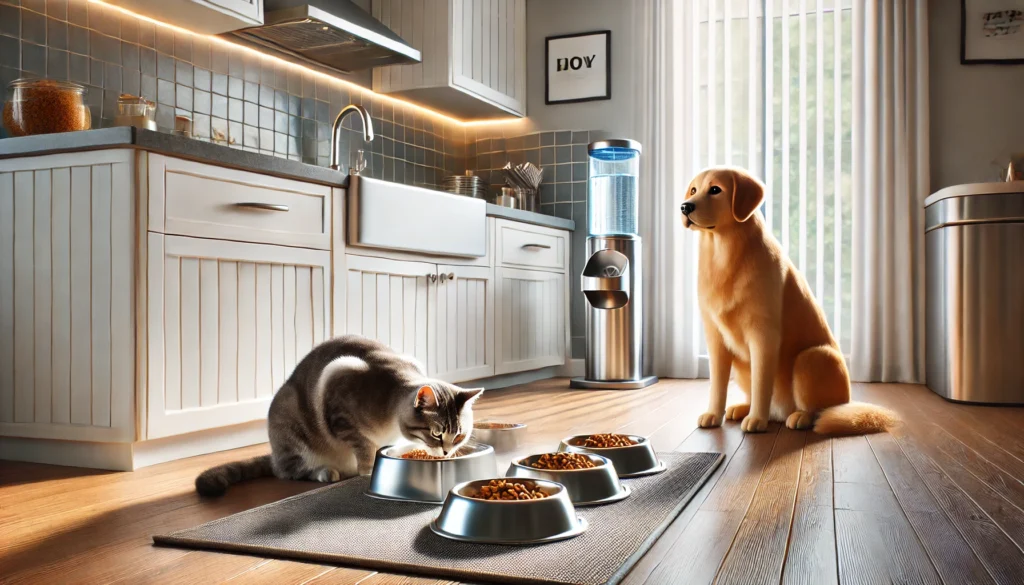Feeding your pets isn’t just about putting food in a bowl — it’s about building healthy habits that support their physical health, emotional balance, and overall well-being. Dogs and cats each have unique nutritional needs, but both thrive when fed with consistency and care.
Here’s a step-by-step guide to creating a balanced feeding routine that keeps tails wagging and purring strong.
Understand Your Pet’s Nutritional Needs
Dogs:
- Omnivores: Dogs can eat both animal and plant-based foods.
- Size matters: A Chihuahua needs a fraction of the food a Labrador does.
- Activity level: Active dogs burn more calories and may need more food or higher-protein options.
Cats:
- Obligate carnivores: Cats need more protein and fat than dogs.
- Small, frequent eaters: Cats tend to prefer multiple small meals per day.
- Hydration needs: Many cats don’t drink much water, so wet food helps.
Set Consistent Meal Times
Routine is key to avoiding overfeeding, underfeeding, and unnecessary begging.
- Same time daily: Feed your pet at the same time(s) every day — once or twice for dogs, two or more times for cats.
- Avoid grazing: Leaving food out all day can lead to overeating, especially in cats.
- Stick to a schedule: Consistency helps with digestion, behavior, and training.
Measure Portions Carefully
Feeding the right amount is essential for weight control and avoiding health issues.
- Use measuring cups: Don’t eyeball it — use tools to ensure accuracy.
- Check feeding guidelines: Start with the recommendations on the food packaging, then adjust as needed based on your vet’s advice.
- Weigh-ins: Regularly check your pet’s weight to adjust portions if needed.
Choose High-Quality Food
Not all pet food is created equal. Opt for brands that offer complete, balanced nutrition and avoid unnecessary fillers or artificial additives.
- Look for certifications: Choose food approved by veterinary or pet nutrition standards (like AAFCO).
- Check ingredients: Real meat as the first ingredient is ideal. Avoid corn, soy, and by-products when possible.
- Consider special needs: Senior pets, puppies, or pets with allergies may need specialized diets.
Incorporate Wet and Dry Food (If Appropriate)
Blending wet and dry food can enhance nutrition and make mealtime more enjoyable.
- Cats benefit: Wet food helps prevent urinary tract issues and increases hydration.
- Dogs enjoy variety: Mixing textures can increase palatability without upsetting their stomachs.
- Portion correctly: Balance calorie content when combining wet and dry food.
Keep Feeding Areas Clean and Comfortable
The environment around food plays a role in how pets eat.
- Clean bowls daily: Bacteria builds up fast in leftover food.
- Use ceramic or stainless steel: Easier to clean and doesn’t harbor bacteria like plastic.
- Quiet location: Feed your pets in a calm spot where they feel safe and undisturbed.
Provide Fresh Water at All Times
Hydration is just as important as food — and often overlooked.
- Change water at least twice daily
- Use a water fountain: Especially for cats, running water can encourage more drinking.
- Multiple bowls: In multi-pet or multi-room homes, keep fresh water available in several locations.
Monitor for Allergies or Sensitivities
Food intolerance isn’t always obvious. Watch for signs that something in their diet doesn’t sit well.
- Common signs: Itching, ear infections, vomiting, diarrhea, or dull coat.
- Elimination diets: If you suspect a problem, work with your vet to identify triggers.
- Hypoallergenic food: Available for pets with specific dietary needs.
Limit Treats and Table Scraps
Even healthy treats can add up. Make sure snacks don’t exceed 10% of your pet’s daily calorie intake.
- Use treats for training only: This reinforces good behavior while keeping intake controlled.
- Avoid human food: Many ingredients (like onions, chocolate, or grapes) are toxic to pets.
- Watch the calories: Small treats can pack a lot of energy — balance accordingly.
Adapt the Routine as Your Pet Grows
Puppies and kittens, adult pets, and seniors all require different feeding strategies.
- Young pets: Need more frequent meals and higher calorie intake.
- Adults: Generally do well with 1–2 meals per day and portion control.
- Seniors: May need lower-calorie diets and joint-friendly ingredients.
Final Thought: Feed with Purpose
A healthy feeding routine builds the foundation for a long, happy life. By choosing quality food, sticking to consistent schedules, and paying attention to your pet’s changing needs, you give them more than a meal — you give them wellness.
Feeding time isn’t just about nutrition; it’s about care, presence, and love. Start today, and watch your pets thrive.






